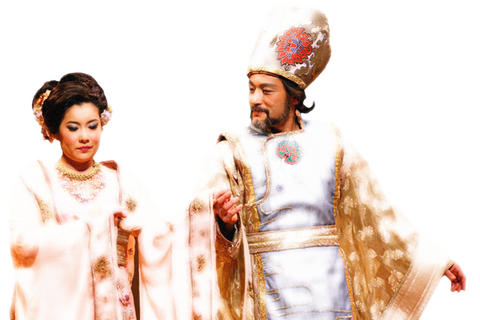Firmiana Rain, which opened at the National Theater, Taipei, on Thursday, was a highly ambitions work of artistic fusion that anyone who knew what they were in for would have attended with trepidation. Despite this, the appeal of Chen May-tchi's (陳玫琪) critically acclaimed composition, which brings ancient Chinese and Japanese court music into the structures of contemporary Western classical music, managed to pack the house. The music was fascinating to listen to, but one was inclined to wish away the distractions of what was happening on stage, which served as a kind of tableaux vivant to illustrate aspects of the music. It did so, unfortunately, to no great effect.
The two lead singers, soprano Kimiko Hata and baritone Kouichi Taira, tackled their parts manfully, but there was no chemistry on stage, and the romance never really got off the ground. This was not helped by some rather bathetic moments, when the effort of achieving high romantic flourishes fell flat. When the heroine discovers her lover in bed with another, the intended effect cannot have been uncontrolled giggling from what was generally a very sympathetic audience trying to come to terms with something new.
Beijing opera singer Liu Fu-hsueh (劉復學) and gezai opera star Tang Mei-yun (唐美雲) were shamefully misused, the former having no opportunity to show off his talents. Tang's performance as the poet Li Bai was a straw at which a grateful audience grasped at as something familiar and comprehensible, and her two cameo appearances garnered more applause than almost any other part of the show.

PHOTO: COURTESY OF NTCH
Hata sang with conviction, but the other members of the cast often showed a lack of commitment, with moments that suggested that they felt ridiculous and ill-used. All of this detracted from a brave effort, undermined by an attempt to cram too much into a single performance.
The Second Goodbye, which opened on the same day in the National Experimental Theater, also set out to fuse many diverse elements, and it came out triumphant. The show, a chamber ensemble compared to Firmiana Rain's orchestral work, was also vastly ambitious in its own terms, with its score for Chinese instruments written by Dutch composer Marlijin Helder, and the combination of the body puppets of Ulrike Quade, Taiwanese glove puppets and the motley repertoire of experimental theater. Quade's performance was outstanding, the complex relationships between actors, puppets and puppeteers well thought out, and a video projection and paddling pool, which stood in for the River Styx, served the story rather than distracted from it.
If one were to find fault, it would have been in the balance of music and voice, when, on a small number of occasions, the accompaniment would drown out the words. This was not a serious flaw, as the dramatic burden is carried by the physical theater and the music. Seen on its second night, the show already had a smooth and well-oiled feel.
Fusions of different traditions will inevitably show the stresses and strains of forcing together diverse elements. Unfortunately for Firmiana Rain, the strains proved too much, and the problems of staging the composition undermined the audience's ability to come to grips with the complexities of the music. Musically much simpler, The Second Goodbye emphasized stage performance, and in the context of experimental theater, where boundaries are much more fluid, created a much more harmonious mix. The Second Goodbye will be performed at the Beijing International Contemporary Theater Festival (北京國際當代戲劇演出季, Nov. 7 to Nov. 10) and the Contemporary Theater Festival in Shanghai (亞洲當代戲劇季, Nov. 13 to No. 14).

Wooden houses wedged between concrete, crumbling brick facades with roofs gaping to the sky, and tiled art deco buildings down narrow alleyways: Taichung Central District’s (中區) aging architecture reveals both the allure and reality of the old downtown. From Indigenous settlement to capital under Qing Dynasty rule through to Japanese colonization, Taichung’s Central District holds a long and layered history. The bygone beauty of its streets once earned it the nickname “Little Kyoto.” Since the late eighties, however, the shifting of economic and government centers westward signaled a gradual decline in the area’s evolving fortunes. With the regeneration of the once

Even by the standards of Ukraine’s International Legion, which comprises volunteers from over 55 countries, Han has an unusual backstory. Born in Taichung, he grew up in Costa Rica — then one of Taiwan’s diplomatic allies — where a relative worked for the embassy. After attending an American international high school in San Jose, Costa Rica’s capital, Han — who prefers to use only his given name for OPSEC (operations security) reasons — moved to the US in his teens. He attended Penn State University before returning to Taiwan to work in the semiconductor industry in Kaohsiung, where he

In February of this year the Taipei Times reported on the visit of Lienchiang County Commissioner Wang Chung-ming (王忠銘) of the Chinese Nationalist Party (KMT) and a delegation to a lantern festival in Fuzhou’s Mawei District in Fujian Province. “Today, Mawei and Matsu jointly marked the lantern festival,” Wang was quoted as saying, adding that both sides “being of one people,” is a cause for joy. Wang was passing around a common claim of officials of the People’s Republic of China (PRC) and the PRC’s allies and supporters in Taiwan — KMT and the Taiwan People’s Party — and elsewhere: Taiwan and

Perched on Thailand’s border with Myanmar, Arunothai is a dusty crossroads town, a nowheresville that could be the setting of some Southeast Asian spaghetti Western. Its main street is the final, dead-end section of the two-lane highway from Chiang Mai, Thailand’s second largest city 120kms south, and the heart of the kingdom’s mountainous north. At the town boundary, a Chinese-style arch capped with dragons also bears Thai script declaring fealty to Bangkok’s royal family: “Long live the King!” Further on, Chinese lanterns line the main street, and on the hillsides, courtyard homes sit among warrens of narrow, winding alleyways and